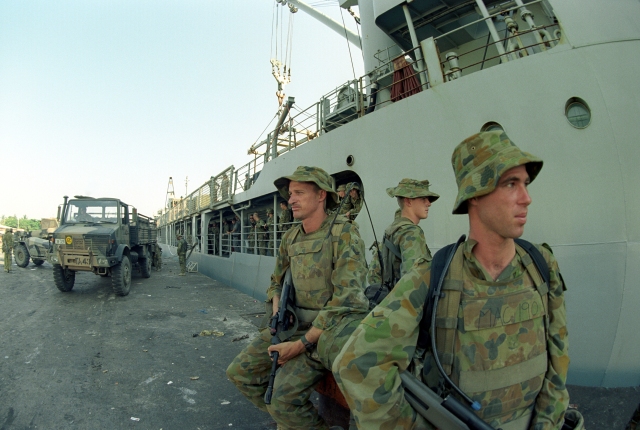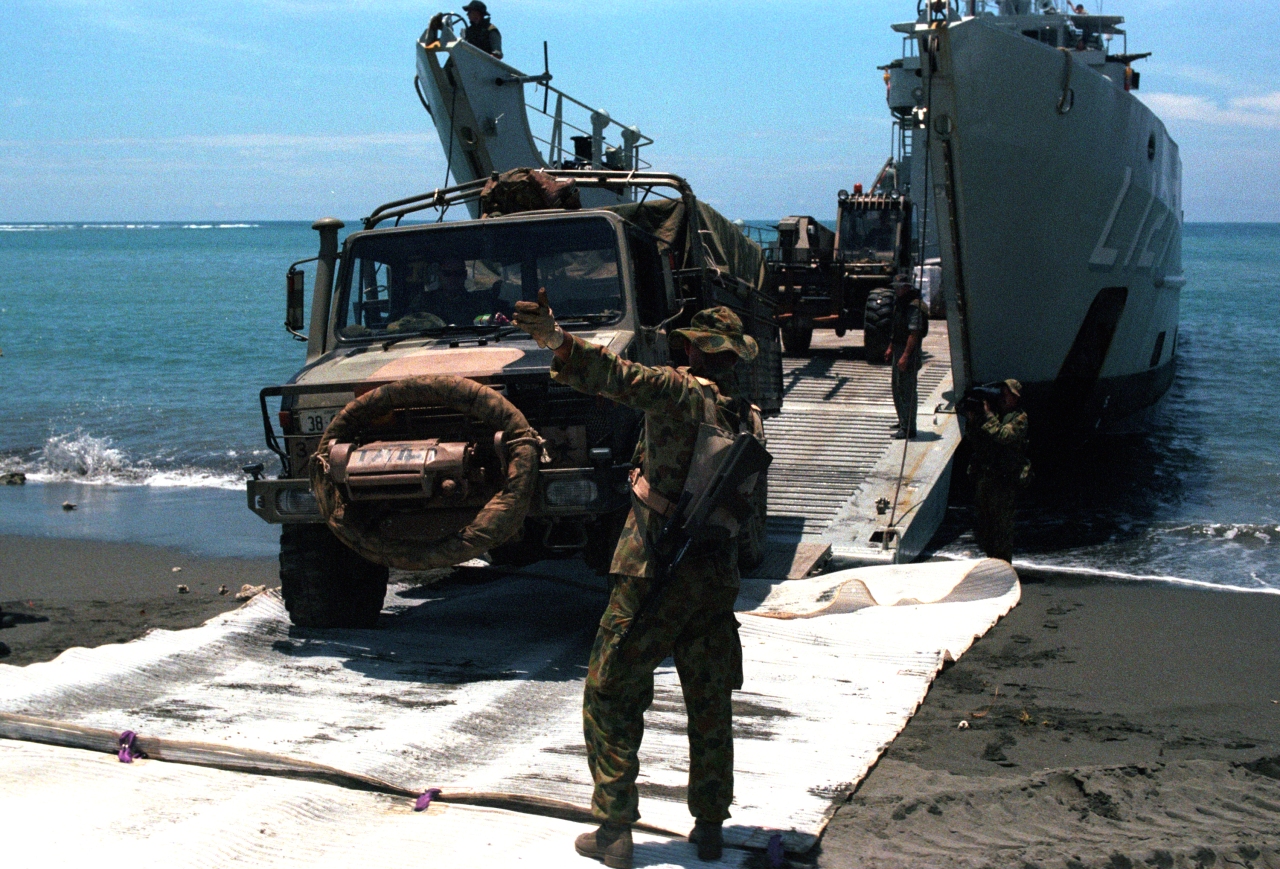By Brigadier Michael Kehoe (Retd).
In the two decades since the Australian deployment to East Timor as part of the International Force East Timor (INTERFET), much has been written about the operation predominantly from the national and military strategic perspectives. This focus is not surprising given Australia’s decision to act decisively in the immediate neighbourhood in a leadership role, and the nature and scale of the intervention, remains unparalleled since Federation. At the operational and tactical level, East Timor may not be a great case study for combat arms officers however for the logistician[1], there are lessons to be learned at every level from the Commander Joint Logistics down to the private soldier. As the operation recedes into history, we need to ensure the key lessons identified do not also fade.
My decision to write something on this topic was prompted by two factors. First, it’s important to learn lessons not only from your own experience but also the experiences of others. This is especially important in the profession of arms as, thankfully, we are not ‘in the fight’ or the same fight, all the time. If we can avoid mistakes by learning from the experience of others, we have a better chance of prevailing when called upon. Second, in the business of the profession of arms, writing ‘places our personal analysis of our unique profession in public view. When writing, our ideas, thoughts and statements are open for debate, criticism and often enhancement by other military and non-military professionals. This…in small measures, contributes to contemporary military discussions and thinking.’[2]
What will follow is not a theoretical exposition, nor a comprehensive evaluation of the mission on which I was involved. It is, as the title suggests, some reflections of my experience as Commanding Officer 10th Force Support Battalion (10 FSB) during those tumultuous months in 1999-2000 and some thoughts on the ‘So what?’ question. I would add two additional qualifications:
My professional library, East Timor-era notebooks and other primary source materials are currently in storage in Canberra. If you feel I am wrong in any recollection of an issue or event, you may be right. I recall Sir Michael Howard commenting that for his first military history project, he chose to research and write the history of his Regiment during a period when he knew almost all the characters and had been involved in most of the Regiment’s key engagements during WWII. Ironically, he found this work the most difficult and he was often amazed by what he thought he knew but didn’t, and the stark differences in opinions about what happened, even among eye-witnesses. Consequently, I’ll simply say that while I cannot hope to tell the whole truth, I have endeavoured to tell nothing but the truth.
I also acknowledge that like everything to do with the character of war, the planning and execution of operations have evolved and will continue to evolve. Issues that bedevilled us 20 years ago may well be solved. Digitization, miniaturization, artificial intelligence, 3D printing, robotics and the integration of these are just some of the known developments that might solve these issues.
I know of at least one talented officer with whom I deployed 20 years ago, doing outstanding work in the area of logistics information and other management systems. I’d be delighted if he told me that all is under control, however notwithstanding technical advances, adversaries have a way of adapting. A deployed force, particularly in the land domain, will always require smart, responsive and hardened combat service support delivered by soldiers who can crew weapon systems and fight; not just in self-defence but with the ability to manoeuvre and deliver effects as part of a wider mission.
The ADF’s inability to learn lessons from planning and executing logistics support to operations in the 1990s is well documented.[3] While these deployments were small in comparison to East Timor, most of the problems that arose with INTERFET had surfaced in some way during previous ADF deployments to Somalia (1993) and Bougainville (1997-2002) and there was ample opportunity for an appropriate lessons learned process to be applied. Unfortunately, this didn’t happen and it is a matter of public record that ‘when the East Timor crisis developed, Defence’s logistic structures, systems and processes did not prove suitable to support the military deployment. It is my aim to provide you with a few observations and experiences as to why this was the case.

How we prepared
Doctrine
Doctrine should be our professional body of knowledge and the foundation for the three pillars of professional learning: formal individual education and training; collective training; and self-development. LTGEN John Coates[1] once said, ‘essentially doctrine is method…if doctrine is uncertain, how does an Army train and for what?’
Logistics doctrine in the late 1990s was poor and reflected the flawed thinking of the Defence of Australia dogma and was not a sound, coherent body of professional knowledge. I recall the relevant Military Land Warfare ‘Logistics’ volume had diagrams with lines of communication represented by broad arrows connecting the industrial heartland of Australia’s south to joint force areas of operation in the north of Australia.
These arrows swept smoothly, seamlessly and inexorably from ubiquitous ‘Log Units’ via multiple modes of transport across boundaries, through Points of Entry to tactical level formations and units. It all seemed, in a diagrammatic sense, wonderfully simple. I don’t recall off-shore scenarios, nor any significant discussion of information management systems for supply chain visibility, or for managing and tracking personnel into and out of the theatre; both were significant issues during the INTERFET deployment.
I’ve always liked the UK analogy of doctrine being like a handrail to guide your way. Thirty years in uniform and another decade working in the professional military education space has reinforced for me the value of sound, well-written doctrine and the absolute danger of doctrine which is out of date, plagiarized without thought from another country, turgid in its flow and poorly expressed. Some US doctrine may as well be written in a foreign language. Doctrine needs to be written in plain English, neither overly prescriptive or too abstract.
The old debate about what we want from doctrine ─ broad conceptual guidance or detailed procedures ─ was supposed to be addressed with a tiered approach where ‘procedural’ doctrine was to be covered by Land Warfare Procedures providing tactical-level details and fundamental skill-sets in a clear context, for the execution of tasks down to the lowest levels. But that had not been implemented fully by 1999 and particularly in Supply Support, there was a dearth of appropriate doctrine on which to anchor training.
Following the introduction of the Standard Defence Supply System (SDSS) – a contemporary logistics information system – we were effectively asleep at the wheel regarding the science and practice of provisioning, and there was no acknowledgement of the challenges of asset visibility in a complex supply chain which experience from the 1990s had shown we were not capable of controlling.
Logistic Preparedness
The ANAO report concluded our logistics systems were not prepared to support the operation undertaken. Nor was 10 FSB and, as Commanding Officer, I bear full responsibility. There were no excuses but there were reasons. In 1999 the role of 10 FSB was to provide third line or General Support to a nominated dependency within an area of operations. When the unit was raised in 1998, the waters were muddied by its dual role as a fourth line logistic support unit in the North Queensland region for Support Command-Australia. Unfortunately, in the supply support capabilities of the unit, there was lack of clarity as to what was deployable and what was not.
The non-combat supplies organisation was ‘Equipment Company’, a predominantly non-deployable element focused primarily on their Support Command task with a significant number of civilian storemen. Additionally, the management of Classes 1, 3 and 5 was done by ‘Combat Supplies Company’ which included barracks responsibilities for the North Queensland-based dependency units. This sub-unit also included a number of civilian APS employees but nothing clearly indicated how we might manage the ‘worst case’ – 10 FSB deployed on operations and a significant proportion of the peacetime dependency remaining in North Queensland, or if deployed, other units replacing them in North Queensland. These Support Command-Australia tasks provided useful technical training opportunities but had a transactional, junior rank emphasis rather than a deeper, supply planning focus.
This dual role was not news to anyone and had been the situation since the 2nd Field Supply Battalion was raised in Townsville in the 1980s. A former CO of that Battalion said to me later when reflecting on these difficulties, ‘senior people just could not envisage an East Timor-type scenario where Australia would carry such a substantial load for logistics support.’
I was fortunate to work for a Commander Logistics Support Force (LSF) – Brigadier Jeff Wilkinson – who ‘got it’ and gave me clear direction on priorities and importantly, top cover. In the first few months of my tenure, I deployed the Battalion, including BHQ, to the field and this shook out cobwebs and allowed new sub-unit commanders to identify and iron out the basic wrinkles. Shortly afterwards, I recall a rather tense visit to the unit by the Support Commander – then Major General Des Mueller – who left me in no doubt that in the area of fourth line logistic support, 10 FSB was ‘the worst performing business unit’ when viewed through Support Command metrics.
In the first few months of my tenure I decided to put up my hand for an Army establishment review that might bring resolution to these issues. This was a dangerous course of action as the 1990s was replete with horror stories of a ‘razor gang’ approach by Army Headquarters Establishment Review teams and I was well aware that a possible outcome may be a reduction in uniformed positions and no resolution to the fundamental problem.
As it turned out, the East Timor deployment and the subsequent decision to raise the Joint Logistic Unit – North Queensland largely resolved the issue.
Brigadier Kehoe’s experiences will continue over coming articles at Logistics in War.
Brigadier Michael (Mick) Kehoe served in a wide range of Australian Army and Joint appointments throughout his long and distinguished career. He is currently advising the UAE defence force professional military education program.
Images from Department of Defence.
[1] I always saw myself as a Combat Service Support officer rather than a logistician and believe the differences are significant. However, for simplicity I’ll use the term logistics.
[2] Chris Field, ‘Two Reasons Military Professionals Must Write’, The Cove, 10 April 2018, available at <https://www.cove.org.au/unit-pme/article-two-reasons-military-professionals-must-write-education-humility/>, accessed 20 May 2019.
[3] I direct those interested to the work of Colonel (Retd) Dr Bob Breen who continues to be a great friend of the ADF in his capacity as a scholar.
[4] Australian National Audit Office report, Management of Australian Defence Force Deployments to East Timor, 20 March 2002.
